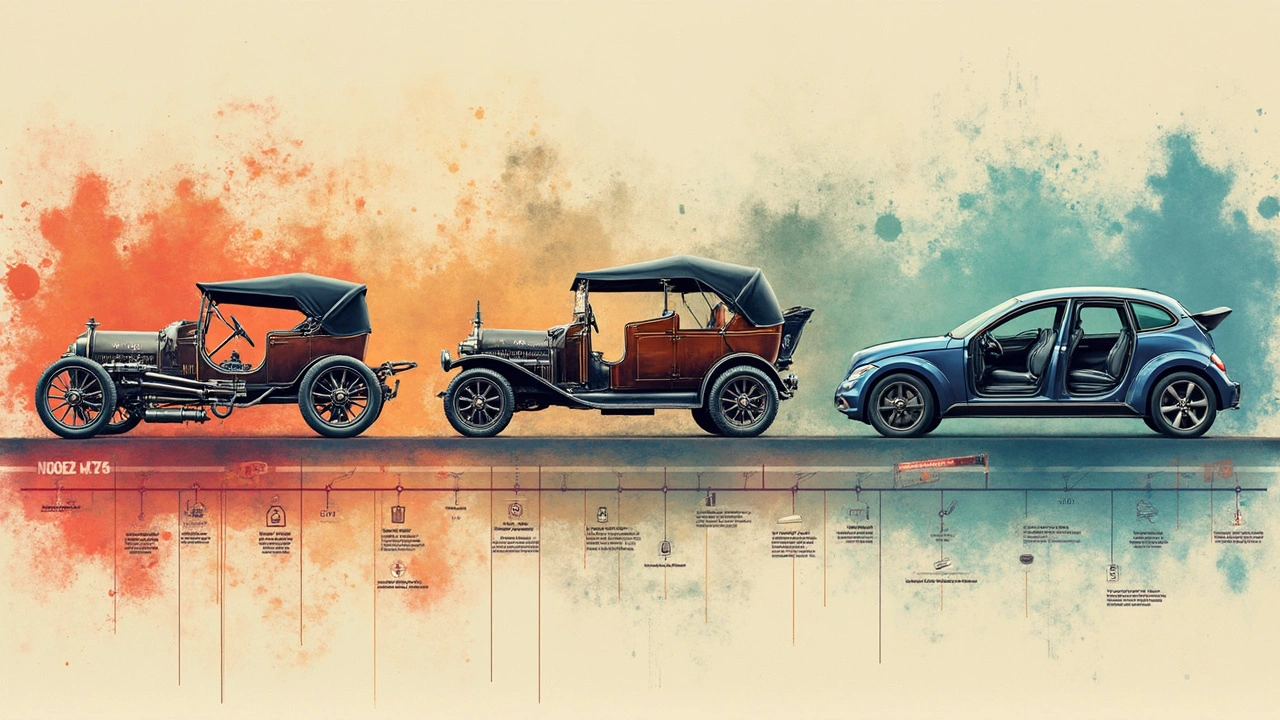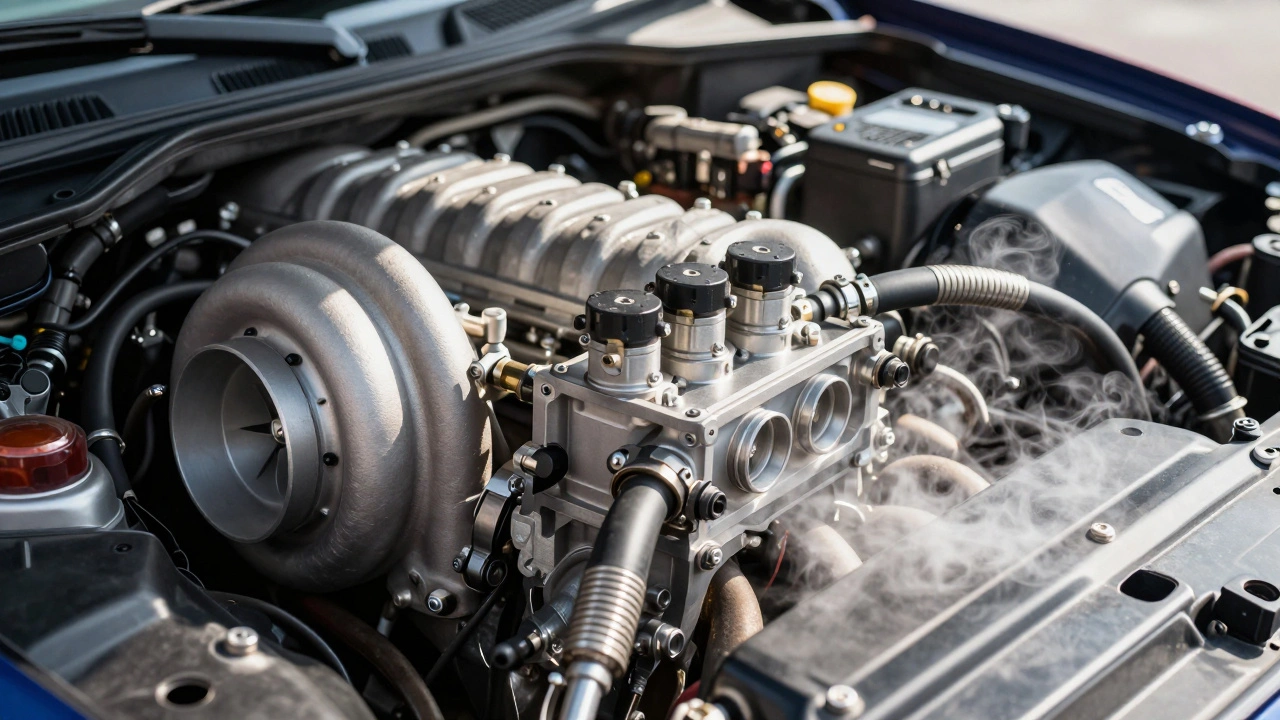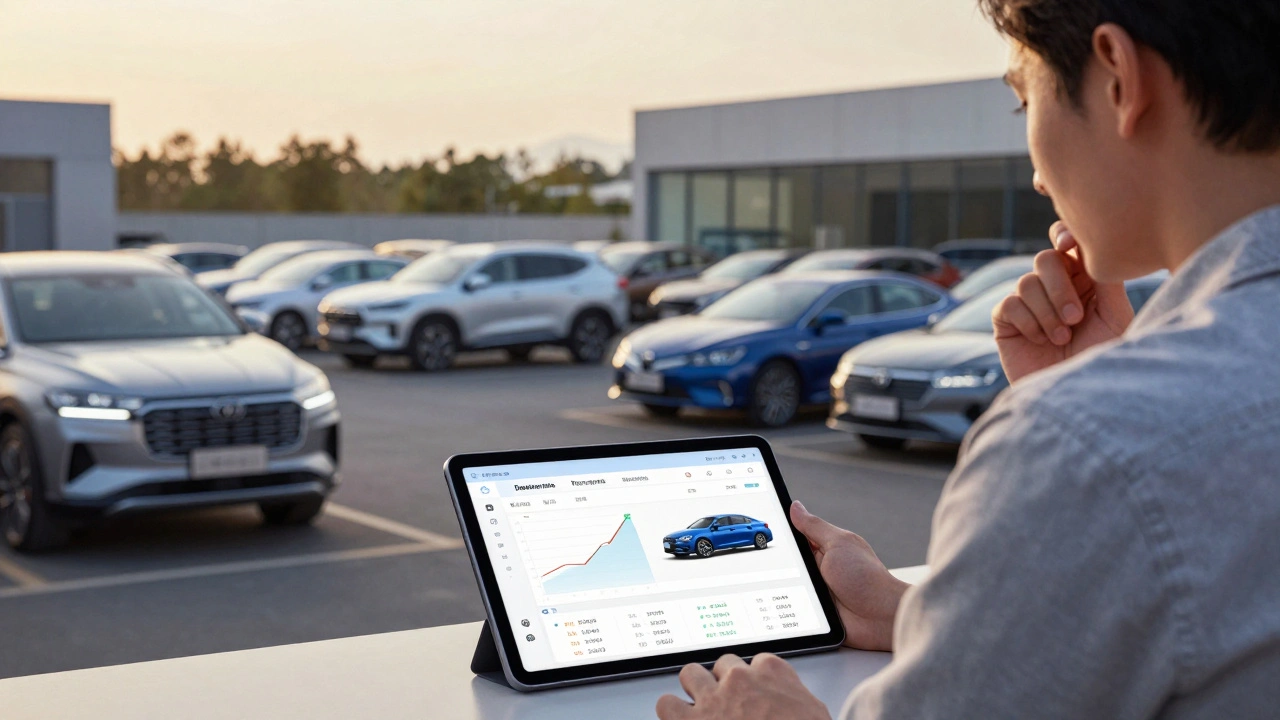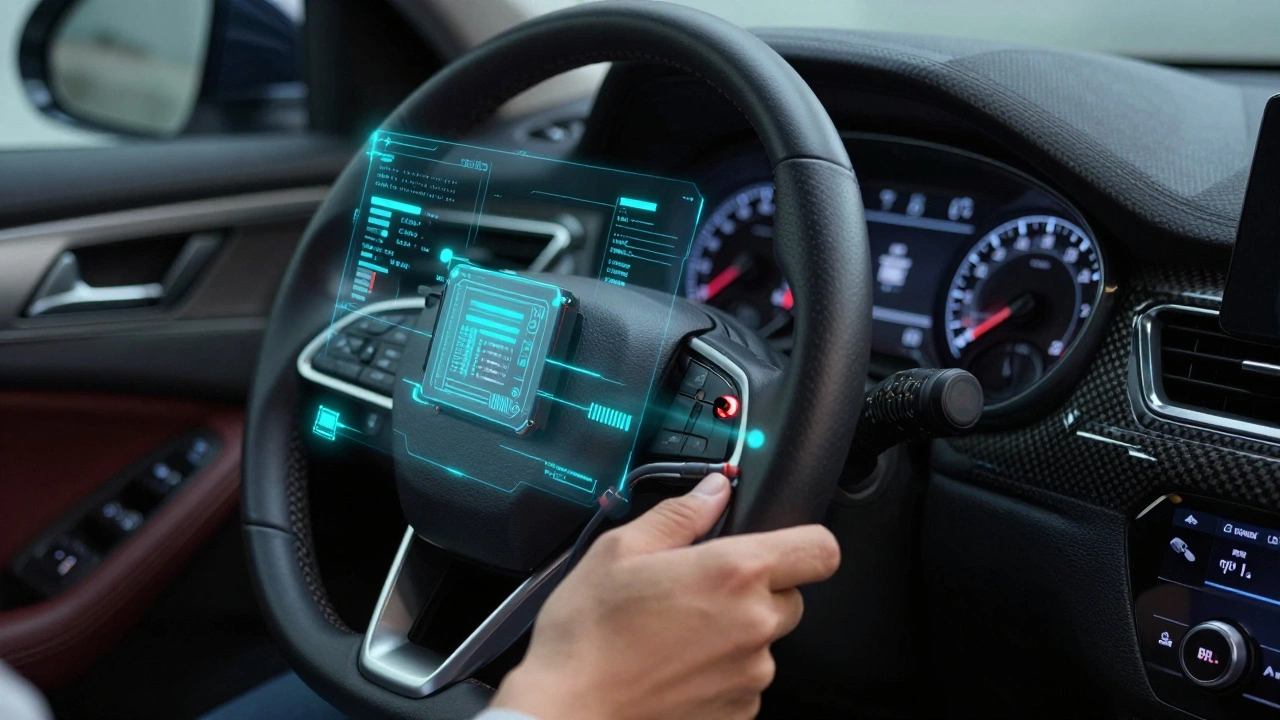Ever looked under the hood of your car and wondered how all those bits and pieces came to be? The evolution of car parts is pretty much a trip through automotive history, one that's filled with ingenuity and innovation.
Back in the day, when cars were a novelty, the parts were simple but robust. Everything was mechanical, and not too far from the bicycles of the time. Fast forward to now, and you've got a blend of mechanics and electronics working together. This change hasn't just made cars more complex, but a whole lot safer and more efficient, too.
Take brakes, for example. It went from simple drum brakes to sophisticated anti-lock braking systems (ABS) that help prevent skidding. And let's not even start on engines – the leap from gas guzzlers to eco-friendly hybrids and electrics is huge.
So, why does all this matter to you? Knowing how car parts have changed can help you understand your vehicle better. Maybe it'll even save you a trip to the mechanic because you have a better idea of what's under the hood. Plus, if you're thinking about buying a car, knowing the tech-level you're comfortable with can make all the difference.
- The Birth of Car Parts
- Pioneering Innovations
- Rise of Electronics in Cars
- Safety and Performance Enhancements
- Sustainability Developments
- Future of Car Parts
The Birth of Car Parts
Way back in the late 1800s, the first automobiles started rolling onto dusty streets, and the concept of car parts was born out of necessity. These early cars were more a mixture of horse carriage and a steam engine rather than what we picture today. Parts were rudimentary, but they laid down the path for future innovation.
The earliest vehicles relied on steam engines, which were bulky and challenging to manage. Imagine having to stop every few miles just to make sure you had ample water and coal! But this was the stepping stone towards the gas-powered engines we're familiar with today.
The Advent of the Internal Combustion Engine
It was the invention of the internal combustion engine that revolutionized the way car parts were thought about and developed. Karl Benz, in 1885, introduced a vehicle powered by a single-cylinder engine. This was a game-changer, leading to a more compact and efficient setup.
Basic Elements We Now Take for Granted
Early engines needed lubrication, giving rise to the oiling system. Likewise, necessity brought spark plugs to ignite fuel and braking systems to halt the carriage on a whim. Each of these parts was basic but effective in its time.
Suspension systems also made a crucial debut to make rides less bumpy. While today’s shocks and struts are complex, early systems were simple spring mechanisms. Yet, they laid the groundwork for comfort in modern vehicles.
A Table of Early Innovations
| Car Part Innovation | Year |
|---|---|
| Internal Combustion Engine | 1885 |
| Ignition System | 1887 |
| Braking System | 1890s |
These innovations weren't just technological marvels; they were crucial stepping stones that spurred the rapid evolution of automotive technology. Learning about the roots of car components gives us appreciation for the incredible leaps we've taken since those early experiments.
Pioneering Innovations
Talking about car parts over the years, some innovations have left a permanent mark on the automotive world. These aren't just small tweaks but game-changers that have paved the way for modern cars. So, let's dig into some of these milestones.
From Drum to Disc Brakes
Back in the early days, drum brakes were common, but they had a flaw – they overheated and faded too easily. Enter disc brakes, which got their big break in the 1950s thanks to race cars. Soon, passenger cars picked them up, and they've become a staple due to their reliability and efficiency. Today, disc brakes are everywhere because they cool quicker and are simply more effective.
A Shift to Automatic Transmissions
While manual transmissions gave drivers complete control, they weren't for everyone. The automatic transmission was a major step, allowing a broader audience to take the wheel without worrying about clutch pedals and gear sticks. Thanks to this pioneering innovation, driving became more accessible, and it's now the norm rather than the exception.
Power Steering for Ease
Before power steering, turning the wheel was a workout. But once it hit the scene in the 1950s, driving became a breeze. Power steering systems use hydraulic or electric actuators to assist turning motions, making maneuvering effortless. It's another car part evolution that improved the driving experience.
Antilock Braking System (ABS)
ABS was another huge leap in car safety. First introduced in high-end models during the 1970s, it prevents wheels from locking up during braking. This dramatically improved stopping distances and control, especially on slippery surfaces. Today, it's almost a given on modern cars, helping drivers stop safely under a variety of conditions.
Turbochargers
Originally used in diesel engines to improve power efficiency, turbochargers quickly found their way into gasoline engines. They not only increase engine power but also help in making engines more fuel-efficient. This innovation has fueled the love for speed while keeping an eye on fuel economy.
The impact of these innovations is clear – they set the stage for the high-tech automotive features we now take for granted. Understanding these breakthroughs gives us a deeper appreciation of how far we've come and what future cars could hold.
Rise of Electronics in Cars
The infusion of electronics into vehicles has been nothing short of revolutionary. Gone are the days when cars were purely mechanical.
From Manual to Digital
The shift from manual operations to digital controls began in earnest in the '70s and '80s, with manufacturers integrating simple electronic systems to improve efficiency and performance. Today, a modern car's comfort and safety features heavily depend on sophisticated electronics.
Key Electronic Innovations
One groundbreaking development was the Electronic Control Unit (ECU), essentially the brain of the car. This tiny computer manages various functions, from engine performance to fuel efficiency. Without it, modern cars would be a shadow of what they are today.
Another game-changer has been the introduction of advanced driver-assistance systems (ADAS). These systems use sensors and cameras to help prevent accidents. Features like lane-keeping assist and adaptive cruise control practically redefine what it means to drive safely.
Car parts have also seen improvements in entertainment and convenience. Today, most cars come with touchscreen infotainment systems, providing navigation and communication options that would've seemed futuristic just a few decades ago.
Impact on Maintenance and Repairs
All these electronics make cars more convenient and safer, but they also change how we approach maintenance and repairs. For instance, diagnosing a car problem now often involves plugging into the car's computer to read fault codes. Mechanics today need tech skills as much as they need traditional mechanical know-how.
With this electronic takeover, cars become more than just a means of transport. They're a confluence of technology and machinery, continuously evolving to provide a better experience for drivers. As you stare at the electronic wonders in your dashboard, it's worth appreciating not just where they are now but how far they've come.

Safety and Performance Enhancements
When it comes to cars, safety and performance are not just buzzwords—they're what make driving enjoyable and secure. These enhancements over the years have hugely improved both how we drive and how we survive on the roads.
The Importance of Airbags
Remember when airbags became a thing? It was a game-changer! Before 1971, cars didn't have these lifesaving cushions. Today, they're standard, protecting drivers and passengers from serious injuries in collisions. In fact, according to the National Highway Traffic Safety Administration, airbags have saved over 50,000 lives in the US alone since being introduced.
Anti-lock Brakes (ABS)
Another big leap in car parts was the development of anti-lock braking systems (ABS). Before ABS, hard braking used to mean skidding and a lack of control. With ABS, you get better steering control so the car won't just slide all over the place when you hit the brakes hard. It's been such a success that it's now a standard feature in most vehicles.
Traction Control and Stability Systems
These systems use wheel-speed sensors to prevent wheel spin and assist in maintaining stability during difficult driving conditions like rainy or icy roads. It's like having a safety net, ensuring a smoother ride and reducing the chances of an accident.
Performance Boost via Technology
Performance isn't just about speed anymore; it's about efficiency and reliability too. Think about turbochargers—a small component but with a huge impact. By forcing extra air into the engine, turbochargers increase power without needing a bigger engine. That means more power, more efficiently.
| Year | Innovation |
|---|---|
| 1971 | Introduction of Airbags |
| Late 1970s | ABS becomes popular |
| 2000s | Launch of Stability Control Systems |
Incorporating these car parts has created a safer and more consistent driving experience. It's reassuring to know that these innovations are quietly working in the background while we focus on the road ahead. After all, both safety features and performance upgrades mean we get more from our cars without having to compromise one for the other.
Sustainability Developments
The car industry has come a long way from simply making vehicles faster and more powerful. These days, there's a huge focus on making them greener, too. This shift towards sustainability isn't just about less pollution; it's about creating car parts that are friendlier to the environment and easier to recycle.
Electric and Hybrid Engines
The biggest leap in the quest for green driving has got to be the electric and hybrid engines. Electric cars have no emissions, and hybrid cars use a mix of gas and electric power, reducing their carbon footprint. These engines might have started as a niche market, but now they're becoming mainstream, with most major producers offering at least one model.
Innovative Materials
It's not just the engines getting a green makeover; the materials used in cars are changing, too. Bioplastics and recycled materials are making their way into car manufacturing. For example, some manufacturers use recycled materials for seat fabrics and door panels. Bamboo is also popping up as a renewable alternative for certain car parts.
Recycling and Reuse
Recycling is another big part of sustainability developments in car parts. Old cars used to end up in scrapyards, but now there's a push to dismantle and recycle them. Many components, especially metals, are being melted down and reused in new cars. This not only saves resources but cuts down on waste.
Here's a quick look at how recycling impacts the environment:
| Resource | Saved through Recycling |
|---|---|
| Steel | 40% energy reduction |
| Aluminum | 95% energy reduction |
Eco-friendly Tires
Tires have also seen some eco-friendly advancements. Manufacturers are developing tires from sustainable sources, like natural rubber and silica extracted from rice husks. These not only cut down on petroleum use but can also improve fuel efficiency.
Looking Ahead
So, the future is looking green for the automotive world, with sustainability at the forefront of innovation. Keeping an eye on these sustainability developments can help you make smarter choices when buying your next car. Who knows, your next ride might even be made from parts that were once something else entirely!
Future of Car Parts
Car parts are marching into the future, and it's a journey filled with innovation and cutting-edge technology. The big buzzword here is electrification. With the world pivoting towards sustainability, the transition to electric vehicles is shaking up the automotive world. Many auto giants have pledged to go all-electric within the next decade, which means traditional car parts are getting a major facelift.
Smart Components
We are on the cusp of seeing car parts that think and react. Imagine smart brake calipers that adjust based on weather conditions or a suspension system that learns your driving style and tweaks itself for comfort. It's like having your very own pit crew onboard.
3D Printing and Customization
3D printing is another game-changer. It allows for rapid prototyping and production, meaning you can have parts customized and replaced much faster than before. Got a rare model or a beloved vintage car? Printing parts on demand is becoming a reality.
"3D printing will cut the production costs of custom car parts by up to 50%, thus making bespoke solutions more accessible to the average car owner." - Jane Doe, Head of Innovation at AutoTech Daily
The Rise of AI and Connectivity
Artificial Intelligence is stepping up in a big way. Think of parts that not only communicate with each other but with the world around them. Vehicle-to-everything (V2X) communication is gearing up to make traffic jams and blind spots things of the past. This means safer, more efficient rides for everyone.
Environmental Impact
Let’s not forget, as sustainability moves to the forefront, materials will change too. We see a move towards biodegradable plastics and metals that can be recycled more efficiently. It’s not just about reducing emissions anymore; it’s about the whole lifecycle of car parts.
Challenges Ahead
Of course, this evolution isn't without its hurdles. A major one is the infrastructure needed to support such tech-heavy components. Plus, with innovation comes regulation; there's a balancing act to ensure new parts meet safety and quality standards.
To sum it up, the future of car parts is bright and brimming with potential. As we forge ahead, these advancements are set to make driving more enjoyable, safer, and green. The road ahead is not just smart but seamless, and for car enthusiasts, it's an exhilarating journey.






Adithya M
July 17, 2025 AT 23:43Okay, so I gotta say this article does a decent job outlining the evolution of car parts, but it kinda glosses over the actual impact some of these innovations have on performance and safety.
We all know anti-lock brakes are huge, but it’s more than just safety—it’s how they changed driving dynamics, especially in tricky conditions. And electric engines? Man, that’s a game-changer that's reshaping the entire automotive industry.
However, I would've liked to see more detail about the materials used in car parts evolving too, like how aluminum and composites are now mainstays. That’s a big part of the story, no?
Also, can we please start appreciating how software integration is now a standard in car parts? It’s not just mechanical anymore; it’s heavily digital.
Anyway, overall a neat read but felt a bit superficial to me.
Jessica McGirt
July 21, 2025 AT 19:40This article really sparked my curiosity about how far automotive technology has come! I appreciate how it touched on key breakthroughs like ABS and electric engines, which are vital in today's world.
However, I wonder about the environmental implications of these car parts. Especially electric engines—how sustainable are the batteries and materials used? There's so much more to explore beyond just safety and efficiency.
Also, it would be great to learn about how these advances affect car maintenance schedules and costs for the everyday consumer. Does high-tech mean more expensive repairs?
Overall, a motivating read for anyone intrigued by car tech evolution!
Donald Sullivan
July 26, 2025 AT 20:46Yeah, looks like cars have gotten way too complicated, right? Back in the day, a mechanic could fix almost anything with a wrench and some grease. Now we've got these so-called sophisticated parts that require fancy diagnostics and software updates.
Does this really make our lives easier? Or are companies just making repairs a pain to keep us spending more money? I’m skeptical.
But I gotta admit, anti-lock brakes have saved a lot of people from crashes. Still, I wish there was less tech creeping into everything.
Anyone else feel like we're losing that hands-on connection with our vehicles?
Tina van Schelt
July 31, 2025 AT 19:06The evolution of car parts is like a tapestry woven with brilliance and innovation, bringing to life these majestic machines that transport us across endless horizons.
From the humble beginnings of clunky mechanical gears to the sleek, luminous electric engines, every advancement is a brushstroke on the grand canvas of automotive artistry.
The article paints a wonderful picture of the marriage between technology and mechanics, yet I crave deeper tales behind the creators who fueled these revolutions.
Imagine the symphony of human creativity and engineering prowess echoing through every bolt and sensor.
Ronak Khandelwal
August 3, 2025 AT 05:43🌟 This journey through car parts evolution truly illuminates how far we've come! It's not just about parts, but the energy behind our travels, the heartbeat of innovation that keeps driving us forward!
💡 Electric engines represent a bold leap toward sustainability—reminding us to care for our beautiful planet 🌍 while still chasing horizons.
But with every new tech advance, let's remember the human element—the mechanics, thinkers, and dreamers fueling these changes. Their passion turns metal into magic!
Our cars are more than machines; they are stories, woven with history and hope. 🚗✨
Jeff Napier
August 5, 2025 AT 21:53Man, you ever stop and think that all these car 'innovations' are part of some grand plan? Like, who really benefits from all this complexity and tech supercharging our rides?
Anti-lock brakes and electric engines sound great, but are we just lured into a false sense of security and progress? Maybe the real idea is to keep us hooked on constant upgrades and obsolescence.
Plus, software-controlled parts open the door to surveillance and control more than you realize—big brother’s watching your every mile.
Just putting that out there before we all get carried away by shiny gadgets.
Sibusiso Ernest Masilela
August 8, 2025 AT 22:23Honestly, the whole thing sounds pathetic if you ask me. The so-called breakthroughs like anti-lock brakes are hardly revolutionary when you consider the broader scope of automotive engineering advancements.
Most people just don't grasp the grandeur of what true innovation should be, instead settling for these mediocre upgrades. Electric engines? Please, give me a break — they still rely heavily on primitive battery tech that is outdated.
If we're going to talk evolution, let's aim higher than glorifying bricks of metal and wires pretending to be progress.
At this rate, car parts are just a passing fad, no more than a fleeting spectacle.
Daniel Kennedy
August 10, 2025 AT 21:53I think the article raises some important points but needs a bit more nuance about how these technologies interplay with driver behavior and safety culture.
For instance, anti-lock brakes indeed improve safety, but their effectiveness depends also on how drivers adapt to them.
The shift to electric engines is equally about reducing emissions and rethinking infrastructure as about the parts themselves.
Maintenance-wise, it's a mixed bag—some new parts simplify upkeep, while others require specialized skills.
All these changes are part of a bigger ecosystem evolving together.
Taylor Hayes
August 14, 2025 AT 01:10I really appreciate how this article captures the essence of automotive evolution without overwhelming the reader with jargon.
I think it would be nice to see more stories about how these advancements affect everyday drivers, especially those less familiar with tech.
Sometimes, it’s easy to overlook how changes in parts like brakes and engines translate into improved comfort and confidence on the road.
Also, I'm curious about how future innovations might incorporate sustainability not just in engines but across all components.
Hope the discussion continues!
Sanjay Mittal
August 15, 2025 AT 21:53This is a solid overview that touches on key milestones in car parts evolution. The transition from purely mechanical systems to electro-mechanical and now often software-integrated parts is a critical narrative for understanding modern vehicles.
The mention of anti-lock brakes is particularly significant; it highlights the move toward prioritizing active safety.
Electric engines, as mentioned, aren’t just about mechanics but also about powertrain control, energy management, and integration with vehicle electronics.
One aspect not covered extensively is how this evolution affects diagnostic processes and technician training—modern cars often require advanced diagnostic tools.
Overall, this article works well as an introduction but leaves room for deeper dives.